
Feature Article
Preparation of Eggs and Egg Products - Safety First
Consuming raw or undercooked eggs can lead to Salmonella infection, which may pose severe and even life-threatening health risks to the patients, especially the susceptible populations. From August 2017 to August 2020, 328 Salmonella food poisoning cases related to food premises (involving 995 victims) were referred by the Centre for Health Protection. To assist the trade in preventing food poisoning caused by Salmonella in eggs and egg products, the Centre for Food Safety (CFS) has published a set of guidelines to provide practical food safety advice on food preparation with eggs. This article provides an outline of the guidelines.
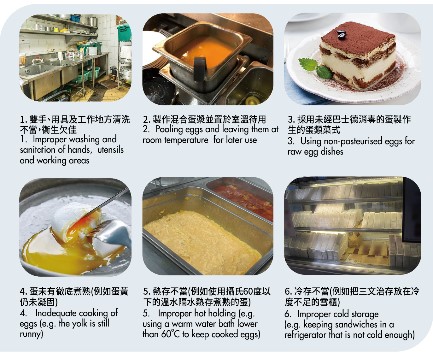
Common high-risk practices of egg preparation in food premises
Choosing Eggs
Choosing safe food ingredients is the first step to ensure food safety. Food businesses should purchase eggs from reliable sources and only accept eggs that are clean and without cracks or leakage. For dishes prepared with lightly cooked or uncooked eggs (e.g. soft-scrambled eggs or tiramisu), it is advisable to use pasteurised eggs, egg products or dried egg powder. Pasteurisation is the process of applying low heat to kill pathogens and deactivate spoilage enzymes.
In some countries, certain shell eggs are produced under certification systems with measures taken at the farm level to reduce the risk of Salmonella contamination. Though claimed to be safe for raw consumption, there are reports that such eggs have been tested positive for Salmonella and have occasionally contributed to foodborne disease outbreaks overseas. Therefore, pasteurised eggs or egg products are still a much safer choice if undercooked eggs are used in food preparation.
Storing and Handling Raw Eggs
Shell eggs should be stored in a cool and dry place (preferably in the refrigerator) and used on a first-in-first-out basis. Improper handling of raw eggs can result in cross-contamination and food poisoning. Food handlers should wash their hands thoroughly before and after handling eggs. They should always clean and sanitise all utensils and other food contact surfaces such as whisks, bowls and working benches before handling eggs and egg products. Washing shell eggs is unnecessary as this will facilitate penetration of bacteria into the egg through pores on the shell. To separate the yolk from the white, a clean egg separator should be used instead of the egg shell, as there may be traces of Salmonella on the surface of the shell.
Pooling Eggs Is a High-risk Practice When Preparing Egg Dishes
Pooling refers to the practice of breaking a number of eggs into a container and using the combined eggs to make multiple servings of egg dishes or as an ingredient for multiple recipes. Pooling of eggs is a common practice in some restaurants to save time and control the portion size. However, if one or more eggs are infected, the whole pool of eggs will be contaminated. If people consume dishes prepared with the contaminated pool of eggs without thorough cooking, they will be at risk of food poisoning. Pooled eggs that are contaminated can also become a reservoir for Salmonella in restaurants as they may contaminate other utensils or foods.
Restaurant staff should break eggs for food preparation only upon receiving orders from consumers. Pooled eggs prepared for later use should be kept in covered containers and placed in the refrigerator. Only the amount needed should be taken out for use. All pooled eggs should be used within the day of pooling. Topping up with new eggs is not suggested. A pool of liquid eggs is more likely to harbour bacteria. It should be cooked thoroughly and should not be used for making raw or partially cooked dishes.
Cook Eggs Thoroughly and Keep Them at a Safe Temperature
The best way to eliminate harmful bacteria is to cook eggs thoroughly until the core temperature reaches 75°C or the yolks are firm. Improper holding temperature of egg dishes is a common cause of local food poisoning outbreaks. If egg dishes are not consumed immediately after preparation, hot foods such as soft-scrambled eggs should always be kept at above 60°C, while cold foods such as sandwiches and desserts should be stored at 4°C or below.
The above advice helps minimise food poisoning risks and applies not only to the food trade, but also home cooking.
Mascot ON in Lesson
Beware of Histamine Poisoning Caused by Improper Storage of Fish
The CFS is following up on a food poisoning outbreak involving tuna fillet. Officers collected samples from the restaurant concerned for testing and the results showed that the outbreak might be associated with histamine poisoning (also known as scombrotoxin fish poisoning (SFP)).
#Mascot ON: Histamine is a toxic metabolite produced by bacteria during spoilage and fermentation of fish and fish products. These histamine-producing bacteria can be found in the skin, gills and gut of freshly caught fish. When these bacteria multiply under suitable temperature, they will convert the amino acid histidine naturally present in the fish into histamine. Consumption of food containing high levels of histamine can cause SFP. Symptoms include a tingling and burning sensation around the mouth, facial flushing and sweating, nausea, vomiting, headache and rash.
SFP can happen with not only mackerel (scombrids) but also certain types of fish like sardine, tuna and anchovy which naturally contain high amounts of histidine. Cooking cannot destroy histamine. Therefore, it is important to properly control the storage time and temperature of fish and fish products:
✅Fish such as tuna and mackerel should be purchased from reliable sources.
✅If the fish is not cooked immediately, it should be put in the refrigerator as soon as possible upon delivery to the restaurant or residence. Prepackaged fish and fish products should be stored according to the manufacturer’s instructions on the package.
✅Frozen fish should be thawed in a correct and safe manner (e.g. in a refrigerator compartment, under running tap water or in a microwave oven). Never defrost fish at room temperature.
✅Cooked fish or ready-to-eat fish products (e.g. tuna sandwiches, opened canned fish) should be eaten as soon as possible and should not be left at room temperature for too long. If the food is not for immediate consumption, it should be placed in a clean, covered container before refrigeration.
Extended reading — Histamine in Fish and Fish Products
➡ https://www.cfs.gov.hk/english/multimedia/multimedia_pub/multimedia_pub_fsf_150_02.html
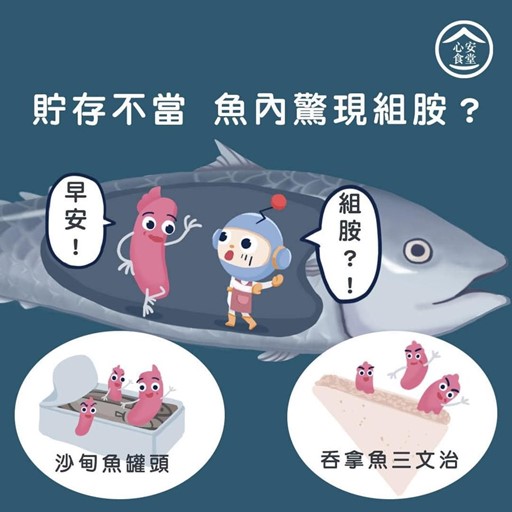
Spot Check
CFS Reminds the Trade to Pay Attention to Food Hygiene in Frozen Confection Manufacturing Process
Summer is here. To ensure that we can enjoy refreshing ice-cream without worries in the hot summer, the CFS of the Food and Environmental Hygiene Department (FEHD) conducted an online talk for frozen confection manufacturers and vendors in May 2022 to share the ways of enhancing food hygiene and safety standards in the frozen confection manufacturing process. Participants were provided with food safety advice on the manufacture and sale of frozen confections, and were reminded to pay attention to the risk of preparing this kind of food on the verge of summer.
In addition, the CFS initiated a targeted food surveillance project on frozen confections in May 2022. Samples of soft ice-cream, sundaes, ice-cream in wrappers, ice-cream scoops and popsicles were collected in stages from frozen confection factories, ice-cream vans, convenience stores, supermarkets and restaurants for testing of pathogens (Salmonella and Staphylococcus aureus) and hygiene indicators (coliform bacteria and total bacterial count). The test results of around 100 samples collected were all satisfactory.
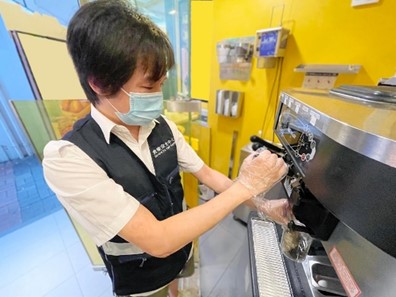
A CFS officer collected a frozen confection sample for testing.
The CFS has published the Food Safety Advice for Manufacture and Sale of Frozen Confections to enhance food safety of frozen confections. To ensure that the food products for sale are fit for human consumption and in compliance with the legal requirements, members of the trade are reminded to heat-treat frozen confections in a proper manner (such as by pasteurisation), and store ingredients and final products at suitable temperatures. They should also thoroughly clean, sanitise and maintain production equipment and utensils from time to time, and establish and implement food safety control plans. Food handlers should adhere to good hygiene practices and maintain high standards of personal and environmental hygiene.


https://www.cfs.gov.hk/english/programme/programme_haccp/programme_haccp_frozenconfections.html
https://www.cfs.gov.hk/english/press/20220613_9549.html
Safe Kitchen/Trade Talks/Food Safety Guidelines
1. Safe Kitchen
Introduction to "Safe Kitchen" Scheme
To facilitate trade members in adopting the Five Keys to Food Safety and good hygiene practices to enhance food safety in daily operation, the CFS has integrated the existing channels of risk communication to launch a new platform, namely "Safe Kitchen", to communicate with the trade. The platform serves to provide food safety information of greater practical importance to meet the operational needs of catering outlets.
The "Safe Kitchen" platform disseminates up-to-date food safety information (including food safety guidelines and relevant legislative amendments) to the trade through a host of channels including WhatsApp, emails and dedicated websites. In response to food poisoning outbreaks in restaurants, the platform will also issue food alerts to remind the trade of the points to note in preventing future occurrences so that the risk of food poisoning can be minimised.
New dedicated websites and risk information exchange platforms will be rolled out under the "Safe Kitchen" Scheme. In addition, training materials tailor-made for the trade and workshops for kitchen staff will be provided to enhance food safety and hygiene awareness among them. Members of the trade are welcome to scan the QR code to download the registration form for the “Safe Kitchen” Scheme in order to receive the latest food safety information.
2. Trade Talks
Talk on "Advisory Note on the Import, Manufacture and Sale of Mooncakes"
As the Mid-Autumn Festival is coming soon, various kinds of mooncakes are put on the market for sale. Delicious mooncakes are a central part of celebrating the festival. Thus, food safety of mooncakes is of great importance. To enrich trade members’ knowledge in this aspect, the CFS organised a talk on "Advisory Note on the Import, Manufacture and Sale of Mooncakes" on 9 August 2022. It was well attended by the trade.
3. Food Safety Guidelines
i. Clean Hands Well to Eat Well
Hand hygiene is essential to food safety. Food handlers with unclean hands may spread pathogenic microorganisms and antimicrobial-resistant "superbugs" from their bodies and raw food to utensils, kitchen surfaces and ready-to-eat food. Apart from poor hand hygiene, using dirty towels for hand drying and misuse of disposable gloves have also been recognised as the causes of previous large-scale food poisoning outbreaks in restaurants. Proper hand hygiene helps reduce the transmission of foodborne diseases and combat antimicrobial resistance along the food chain.
When to Wash Your Hands?
Maintaining proper hand hygiene through washing hands with liquid soap and water is the most effective way for food workers to prevent the spread of infectious diseases. They should wash hands before and after handling food or wearing disposable gloves, and in the course of food preparation when hands may get dirty, such as after touching the face, coughing, sneezing, blowing the nose, using the toilet, smoking, completing cleaning duties, as well as after coming into contact with money, wastes, mobile phones, chemicals or raw food.
As mobile phones have become an indispensable part of our lives, it is now more likely for bacteria on the surface of the phone to be transferred to our hands and onto our food. Mobile phones may turn into a source of both contamination and distraction for food handlers. Therefore, the use of mobile phone should be avoided during work and limited to during breaks or in the changing room.
How to Wash Hands Properly
Food handlers should wash hands with liquid soap and water and rub hands for 20 seconds, as liquid soap and water can remove grease and dirt and kill foodborne microorganisms more effectively. To facilitate proper and efficient hand washing, food premises should provide for their staff at the wash basins the following: liquid soap, automatic or hands-free (e.g. foot-operated or elbow-operated) water taps, a continuous supply of clean running water (warm water can encourage hand washing in cold weather), disposable tissues for hand drying and a rubbish bin with an automatic-closing lid. The management of food premises may also display posters of hand washing guidelines to remind staff of proper hand washing procedures.
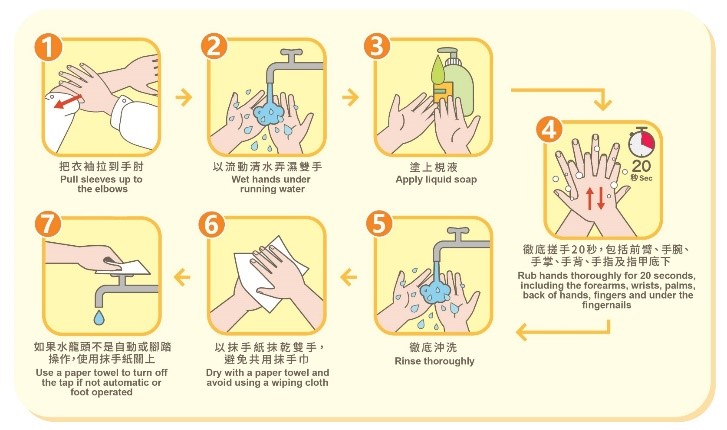
How to wash hands properly for food handlers
Wearing Disposable Gloves Cannot Replace Hand Washing
Proper use of disposable gloves facilitates safe handling of food, especially when there are wounds or cuts on hands, or when we are handling ready-to-eat food like sandwiches and salads. However, it is not a substitute for proper hand washing.
Disposable gloves should be worn properly when preparing food. Food handlers should wash hands thoroughly before wearing, after removing and when changing gloves. Used disposable gloves should be discarded and should not be reused. Change gloves at appropriate times, including between handling raw and cooked food, when the gloves are wet from sweaty hands, torn or soiled, after completing each task such as handling of garbage, and between job or shift rotation. Using tools like food tongs can also minimise bare-hand contact with food.
In support of the World Food Safety Day on 7 June themed "Safer food, better health", the CFS took the opportunity to promote the importance of hand hygiene in enhancing food safety and set hand hygiene as the theme for Food Safety Day 2022. It helps ensure food safety and keep customers satisfied when food handlers observe hand hygiene. Let’s clean hands well to eat well, and practise good hand hygiene together!
ii. Preserve Food by Freezing – How to Handle Frozen Food Safely
Freezing, aside from canning, is a common means of preserving food. Freezing maintains the quality of food but, unlike canning, allows some pathogenic microorganisms to survive.
How Does Freezing Preserve Food?
Freezing extends the shelf life of food as storing food at -18°C can inactivate enzymes and microorganisms (including bacteria, yeasts and moulds) therein. By freezing, the water in food turns into ice crystals, depriving microorganisms of the water they need for growth. Parasites like trichina can also be destroyed at refrigerated temperatures. However, freezing cannot eliminate bacteria and viruses. Viruses like norovirus remain infectious even at refrigerated temperatures. Besides, any microorganisms present in the food may also become active again when the food is defrosted.
Blast freezing is used commercially to freeze food such as fruit, meat and fish quickly, with the use of high velocity cold air at -30°C to -40°C. Food can be frozen in a blast freezer within three hours, which is less than half of the time required for a conventional freezer. The benefit of blast freezing is that it better ensures food quality. During blast freezing, the ice crystals formed in food are smaller, which reduce cell damage and preserve food texture.
How Long Can Food be Frozen?
If stored in the freezer at -18°C or below as recommended, food such as meat can be kept for 6 to 12 months. Keeping time, which varies depending on the food, is usually indicated on the product label. Freezing in itself does not destroy nutrients in food. During storage in the freezer, there is little change in the nutritional value such as protein in meat and poultry.
Some may be concerned that food stored in the freezer will become shrivelled and tough, discoloured, or covered in ice crystals. These are signs of freezer burn, which affects the quality but not the safety of the food. Food with colour change is still safe to eat, while freezer-burnt parts can be removed before or after cooking as desired. To avoid freezer burn, wrap or package the food properly before storing it in the freezer.
Defrost Frozen Food Safely
While bite-sized food like dumplings and diced mixed vegetables can be cooked without defrosting, bigger food items like raw meat and poultry must be properly thawed before cooking. If the food is still frozen or partially frozen, a longer cooking time is required to avoid the food being cooked on the outside but undercooked inside, which can harbour harmful bacteria.
Frozen food should be thawed in the refrigerator at 0°C to 4°C to inhibit bacteria growth during defrosting. Other thawing alternatives include placing the food under cold running water or putting it in the microwave oven. When thawing, frozen food should be placed in a leak-proof container to prevent cross-contamination with other food.
Food thawed under cold running water or in the microwave oven should be cooked immediately after defrosting as they may be exposed to the temperature danger zone between 4°C and 60°C that favours microbial growth. For frozen ready-to-eat food such as raw oysters and sashimi that will not be cooked further, they should be defrosted in the refrigerator to avoid reaching the dangerous temperatures. Food should not be defrosted at room temperature. Do not refreeze defrosted food unless it has been properly thawed in the refrigerator.
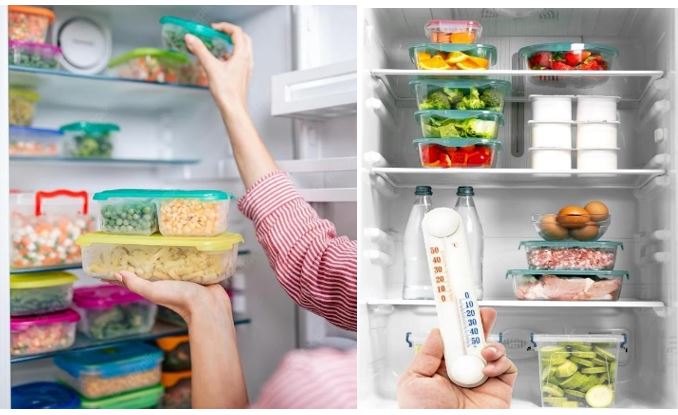
Food properly wrapped or packaged (left) and stored in the refrigerator at 0°C to 4°C for thawing (right)
Key Points to Note
While freezing inactivates enzymes and harmful microorganisms in food, it cannot eliminate bacteria and viruses. Proper handling of frozen food is essential.
Defrosting frozen food inside the refrigerator at 0°C to 4°C is preferred. It may take a longer time and therefore should be planned ahead.
Defrost by the microwave oven or cold running water are both feasible, but the food should be cooked immediately after defrosting.
iii. Stop Import or Sale of Puffer Fish and Food Containing Puffer Fish

Puffer fish, mainly in the families Tetraodontidae and Diodontidae, and some fishes in the groups of Canthigasteridae, Molidae, etc., possess a potent neurotoxin known as tetrodotoxin (TTX). It can cause muscle paralysis and even death from respiratory failure in severe cases. There is currently no antidote for TTX poisoning. Moreover, TTX is heat-stable and cannot be destroyed by cooking, freezing or drying.
At present, there is no internationally accepted guideline, procedure and accreditation scheme for the preparation of puffer fish to ensure that the flesh is not contaminated with TTX. According to the US Food and Drug Administration, there is no adequate sampling scheme that can assure a safe lot of puffer fish since any single fish may contain a lethal dose of TTX.

Please visit the following website for further details on puffer fish:
(https://www.cfs.gov.hk/english/faq/faq_17.html).
News on CFS
1. CFS New Broadcast Van Now in Service
The CFS’s new broadcast van, decorated with cartoons on its body to promote food safety and hygiene messages, is now in service. The van is equipped with a large television screen for showing videos produced by the CFS to improve visitors’ understanding of the Five Keys to Food Safety.
Adopting a lively design, the van aims to promote in an easy-to-understand manner the Five Keys to Food Safety, which include:
- Choose - choose safe raw materials;
- Clean - keep hands and utensils clean;
- Separate - handle raw and cooked food separately;
- Cook - cook food thoroughly to ensure that the core temperature reaches at least 75°C; and
- Safe temperature - keep hot food at above 60°C and cold food at 4°C or below if it is not consumed immediately.
Members of the public are welcome to watch some fun-filled videos about food safety played on the van if they see it nearby. Those who would like to receive the latest activity updates or food/allergy alerts of the CFS may scan the QR code displayed on the van.





2. Risk Assessment Study Results on Sodium Content in Dim Sum Announced
On 12 July 2022, the CFS of the FEHD held a press conference, in which the risk assessment study results on the sodium content in dim sum were presented by Mr Cheung Leong, Chairperson of the Committee on Reduction of Salt and Sugar in Food (CRSS); Dr Christine Wong, Controller of the CFS of the FEHD; and Dr Samuel Yeung, Consultant (Community Medicine) (Risk Assessment and Communication) of the CFS. The objectives of the study were to investigate the levels of sodium in dim sum available in the local market; serve for continuous monitoring of the changes in the sodium content in dim sum available in the local market; facilitate the discussion with the trade to provide healthier food products with less sodium through recipe reformulation; and formulate advice for the public to lower the sodium intake from dim sum.
The trade should be aware of the sodium content of dim sum on sale, and reduce the sodium content of dim sum through modification of preparation methods and ingredients by making reference to the CFS’s Trade Guidelines for Reducing Sodium in Foods (e.g. by choosing ingredients with lower sodium content, and using natural ingredients for flavouring and marinating). When setting a set menu, combinations of dim sum items with higher sodium content should be avoided, while those with lower sodium content should be offered more often.
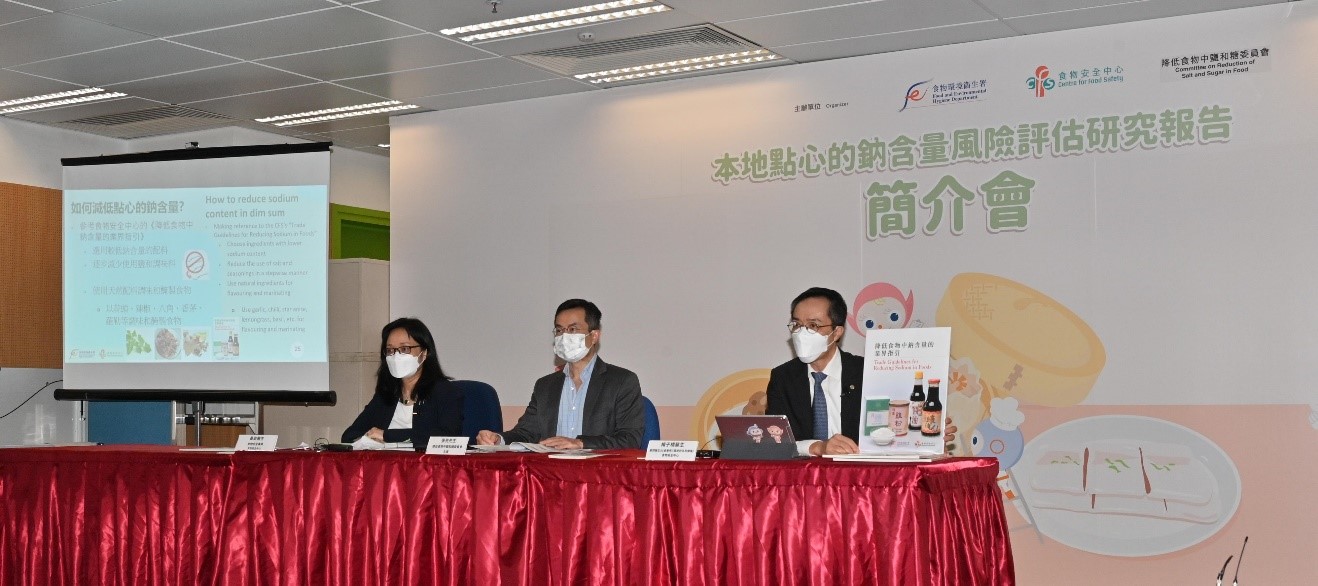
Mr Cheung Leong, Chairperson of the CRSS (centre); Dr Christine Wong, Controller of the CFS of the FEHD (left); and Dr Samuel Yeung, Consultant (Community Medicine) (Risk Assessment and Communication) of the CFS (right) explained the study results.

Mr Cheung Leong, Chairperson of the CRSS (third from right); Dr Christine Wong, Controller of the CFS of the FEHD (third from left); Dr Samuel Yeung, Consultant (Community Medicine) (Risk Assessment and Communication) of the CFS (second from right); Mr William Ma, President of the Hong Kong Chinese Chefs Association (first from right); Mr Tony Chow, Senior Instructor of the Chinese Culinary Institute (first from left); and dim sum chef Mr Mak Kwai-pui (second from left) attended the media briefing to remind the public to avoid excessive sodium intake.
3. Food Safety Talks for Catering Businesses

A number of local food poisoning cases which happened in June 2022 were related to the consumption of partially cooked eggs. Dishes like soft-scrambled eggs with rice and tiramisu were involved. Raw or undercooked eggs are high-risk foods. If not handled properly, egg dishes are prone to Salmonella contamination, leading to food poisoning. Therefore, the CFS has organised additional food safety talks on eggs and egg products to remind the staff of the relevant businesses to maintain good personal hygiene and follow the Trade Guidelines on Safe Preparation of Eggs and Egg Products when handling and selling egg dishes.
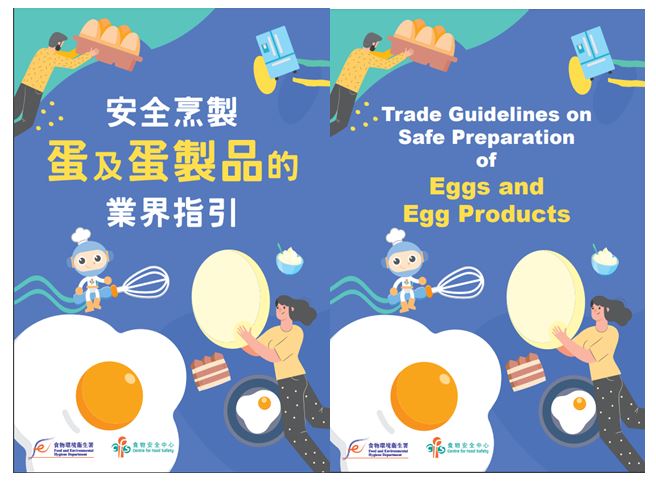

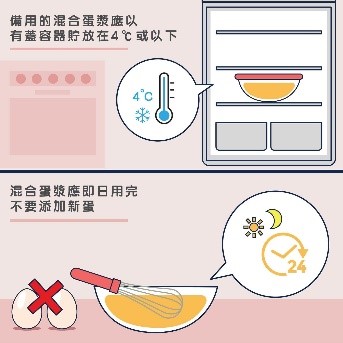
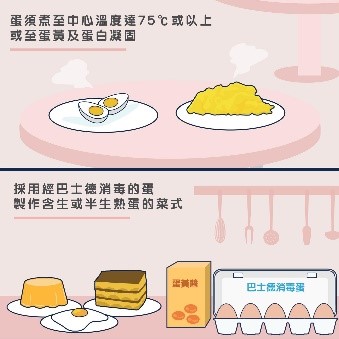
4. The 77th meeting of the Trade Consultation Forum
The 77th meeting of the Trade Consultation Forum was held on 30 June 2022. The CFS and the trade exchanged their views on topics including "New Arrangement for Import of Frozen/Chilled Poultry via Hong Kong-Zhuhai-Macau Bridge", "Food Traders’ Registration", "Trade Guidelines on Safe Preparation of Beef Burgers" and "Guidelines for Food Businesses on Providing Consumer Advice on High-risk Food on Menus". For details, please visit:
https://www.cfs.gov.hk/english/committee/Notes_and_Presentation_Materials_TCF77_20220630.html


Ask Our Mascots
Latest Report on Sodium Content of Dim Sum (With Practical Tips to Reduce Sodium Intake)
#Mascot ON: Among the many different types of dim sum, do you know which one is the highest in sodium (salt)? How can we cut down on sodium intake from dim sum? Let’s take a look at the latest CFS report on the sodium content of dim sum!
The CFS collected samples of 12 types of dim sum and 4 types of sauces from more than 50 Chinese restaurants and dim sum shops for sodium content analysis. The results showed that:
- some samples of shrimp siu mai and spring roll with shrimp were considered high in sodium (i.e. over 600mg per 100g of food)
- some samples of rice roll were considered low in sodium (i.e. not more than 120mg per 100g of food)
- consumption of dim sum with sauces served might increase the sodium content by more than two times
The top three types of dim sum with the highest sodium content (per 100g of food) were:
- shrimp siu mai (590mg)
- spring roll with shrimp (480mg)
- steamed minced beef ball (440mg)
#CFSTeam: We have prepared some tips for you to reduce sodium intake from dim sum:
- Be aware that the sodium content of certain types of dim sum is higher. Choose carefully and maintain a balanced diet with variety.
- Request the dim sum to be served separately from sauces.
- Taste before dipping in sauces; if needed, dip lightly in the sauces.
- Read the nutrition labels when buying prepackaged dim sum and choose those products with lower sodium content.
#Mascot MUI: There is a decreasing trend in the sodium content of some dim sum samples as compared with the results of previous studies, revealing the possibility for the trade to reduce the sodium content in dim sum. The trade may refer to relevant CFS guidelines and provide consumers with healthier choices through modification of preparation methods and ingredients.
For more details about the report, please visit:
https://www.cfs.gov.hk/english/programme/programme_rafs/programme_rafs_n_01_31_Sodium_content_in_dim_sum.html

Knowledge Improvement Quiz
- Which of the following is a correct way to handle eggs or egg products?
- Wash the shell thoroughly with clean water before storing the eggs
- Cook the eggs thoroughly until the core temperature reaches 75°C or the yolks are firm
- Keep sandwiches and desserts with egg ingredients at room temperature
- For at least how long should we rub our hands when washing hands for good hygiene?
- 5 seconds
- 10 seconds
- 20 seconds
- Which of the following methods can prevent histamine poisoning?
- Consume cooked fish and ready-to-eat fish products as soon as possible
- Purchase fish from illegal sources
- Defrost frozen fish at room temperature
Answers:
1. B 2. C 3. A
Diary of Mascot ON
Insight from a Meat Cutter

Mrs CHU: Hey, are you AhOn? You look so cool and cute in person!
AhOn: Hello, do you want to buy some pork?
Mrs CHU: Well… can I take a photo with you?
AhOn: Photo? Sure, but before that, please allow me to share with you some food safety tips on handling raw meat at home.
First of all, keeping the hands clean is crucial when handling foods. Wash your hands with clean water and liquid soup and rub the hands for at least 20 seconds:
![]()
 after grocery shopping;
after grocery shopping;

![]() before and after handling raw meat;
before and after handling raw meat;
![]()
![]() before putting on and after removing gloves;
before putting on and after removing gloves;
![]()
![]() after going to the toilet; or
after going to the toilet; or
![]()
![]() before eating.
before eating.
If you have any wound on your hands, cover it properly with a waterproof bandage and put on protective gloves before handling raw meat to prevent Streptococcus suis or Group B Streptococcus infection!
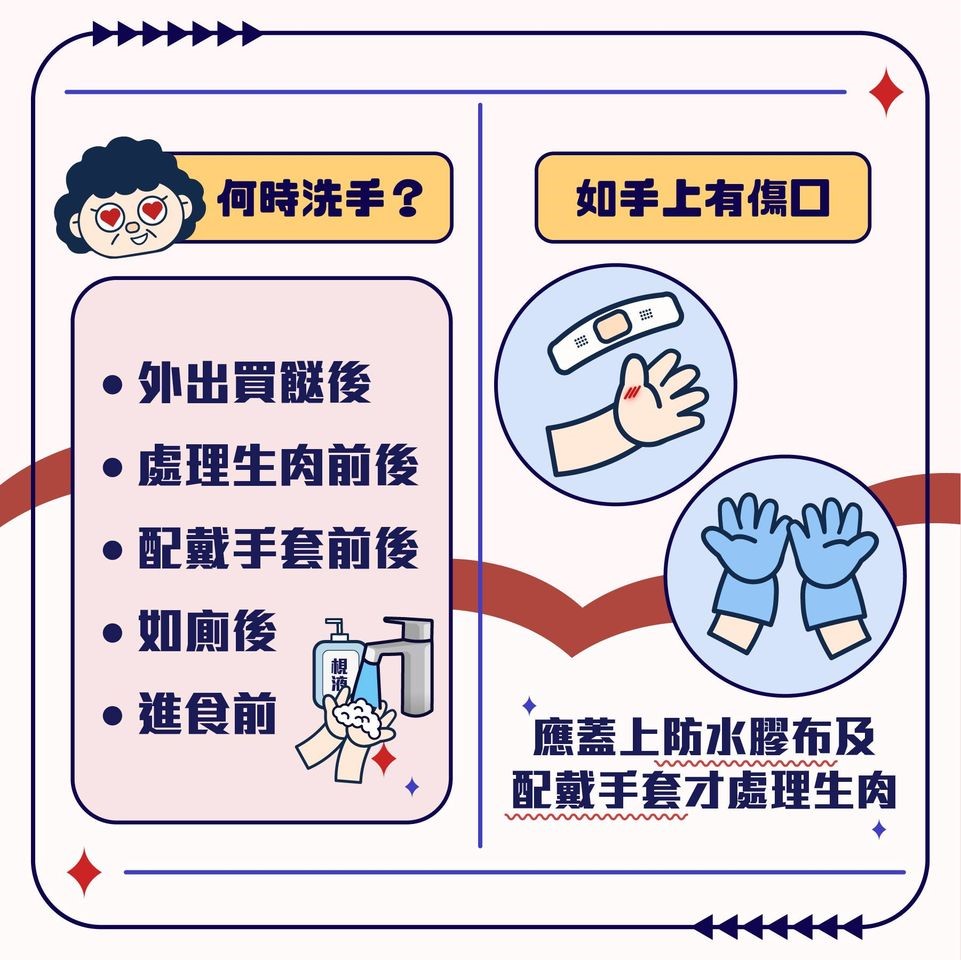
Besides, one should use different utensils (like knives and cutting boards) for raw and cooked ingredients to prevent cross-contamination. Finally, we must make sure that the meat is thoroughly cooked before serving! Now, say cheese, yeah !

Mrs Chu: ![]()
![]()
![]()